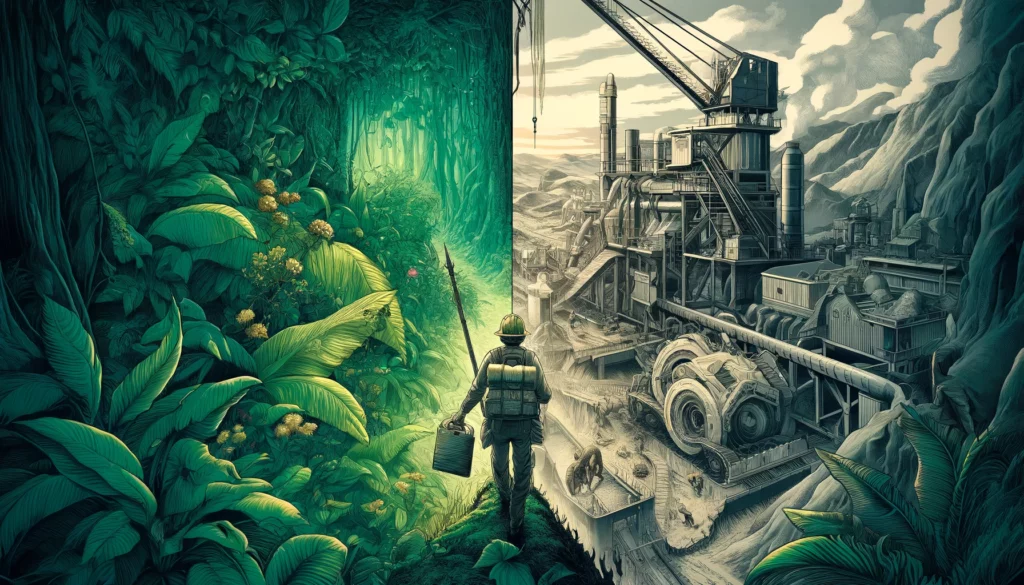
In the realm of business, the path to success diverges: some choose to explore cautiously, while others boldly exploit opportunities. The key lies in striking a balance between these approaches. By strategically combining exploration and exploitation, businesses can unlock unparalleled growth potential. This blog delves into the art of navigating this contrast, showcasing how harmonizing these strategies can lead to sustained success. Learn how to harness the power of both exploration and exploitation to propel your business forward and stay ahead in today’s dynamic market landscape.
Table of Contents
Exploring the Continuum
Essence of Explore-Exploit
Companies face a constant dilemma when it comes to exploring new opportunities and exploiting existing ones. They must navigate between these two strategies to ensure sustainable growth. The core concept lies in finding the delicate balance between exploration and exploitation. This balance is crucial for long-term success.
To thrive in today’s competitive landscape, companies must understand how to effectively manage the explore-exploit continuum. By embracing both exploration and exploitation, businesses can stay innovative while also capitalizing on their current strengths. Finding this balance is key to adapting to changing market conditions and customer needs.
Balancing exploration and exploitation is essential for companies seeking continuous growth. While exploration involves seeking out new opportunities and innovations, exploitation focuses on maximizing the potential of existing resources and knowledge. By mastering both strategies, organizations can remain agile and responsive in dynamic markets.
Exploring vs Exploiting

Exploration involves venturing into uncharted territories, experimenting with new ideas, and taking calculated risks. It allows companies to innovate, adapt to changing trends, and stay ahead of competitors. However, excessive focus on exploration can lead to uncertainty and inefficiency.
On the other hand, exploitation centers around optimizing existing resources, processes, and technologies to maximize short-term gains. It provides stability, efficiency, and predictability for businesses. Yet, solely relying on exploitation may hinder innovation and limit long-term growth potential.
Both exploring and exploiting have their advantages and drawbacks. Exploration fosters creativity and innovation but carries higher risks. Exploitation ensures efficiency and profitability but may lead to complacency. Successful organizations strike a balance between these approaches based on their goals and market conditions.
Applying the Continuum
Effectively applying the explore-exploit continuum requires a deep understanding of its dynamic nature in business decision-making. Companies must be agile enough to switch between exploration and exploitation based on evolving circumstances. This flexibility enables them to seize emerging opportunities while leveraging existing strengths.
Real-world examples showcase how companies leverage the explore-exploit continuum for growth. Organizations like Google constantly explore new technologies while optimizing their core search engine algorithms—an example of successful exploration alongside exploitation. By maintaining this delicate balance, companies can drive sustainable growth over time.
Applying the explore-exploit continuum strategically allows businesses to capitalize on both innovation-driven growth through exploration and stability-driven growth through exploitation. By embracing uncertainty, fostering experimentation, and adapting quickly to market changes, companies can unlock new avenues for expansion.
Growth Through Exploration
Exploration plays a vital role in driving innovation and sustained growth for businesses. By encouraging a culture of experimentation and risk-taking, companies can uncover new opportunities that fuel long-term success. Embracing uncertainty becomes a catalyst for breakthrough innovations that set organizations apart from competitors.
Experimentation serves as a cornerstone of exploration by allowing companies to test new ideas, products, or processes without fear of failure. Through continuous learning from successes as well as failures, organizations can refine their strategies, improve their offerings, and stay ahead in rapidly evolving markets.
Embracing uncertainty opens doors to unexplored possibilities for growth by challenging traditional norms and pushing boundaries. Companies that dare to venture into unknown territories often reap rewards in the form of groundbreaking innovations that revolutionize industries.
Misconceptions Addressed
Common Myths Debunked
Exploring and exploiting one’s way to growth often comes with misconceptions that need addressing. One common myth is that focusing solely on exploration leads to success, neglecting the importance of exploitation. This misconception can hinder companies from achieving sustainable growth as both mindsets are crucial.
Another myth is that exploitation is solely about maximizing current resources without room for innovation. In reality, an ambidextrous mindset involves balancing both exploration and exploitation for optimal growth. By understanding these myths, companies can adopt a more balanced approach to business development.
Clarity on Exploration
Exploration in a business context involves venturing into new territories, whether in products, markets, or technologies. It’s about taking calculated risks to uncover opportunities that align with the company’s goals. Fostering a culture that encourages exploration allows employees to experiment and innovate freely.
By embracing exploration, companies can discover untapped market potential and stay ahead of competitors. It’s not just about trying new things but also about learning from failures and adapting strategies based on feedback. This approach enables businesses to remain agile and responsive to changing market demands.
Exploitation Misunderstood
Exploitation is often misunderstood as simply maximizing existing resources without room for creativity. However, effective exploitation involves leveraging current capabilities efficiently to drive growth. It complements exploration by capitalizing on established strengths while simultaneously exploring new opportunities.
Companies that effectively exploit their resources can streamline operations, reduce costs, and improve productivity. By utilizing existing assets innovatively, businesses can create value for customers and sustain long-term growth. Understanding the true essence of exploitation is key to achieving a balance between innovation and efficiency.
Reality of Growth Strategies
Implementing growth strategies in competitive markets presents challenges that companies must navigate strategically. The reality is that competition is fierce, requiring businesses to constantly evolve their approaches to stay relevant. Adapting strategies based on market dynamics and consumer preferences is essential for long-term success.
Challenges such as changing consumer behavior, technological advancements, and economic fluctuations necessitate a flexible approach to growth planning. Companies must be prepared to pivot quickly in response to external factors while staying true to their core values and objectives. By acknowledging the ever-changing landscape of business, organizations can thrive amidst uncertainty.
Culture and Growth
Cultural Impact
Organizational culture plays a pivotal role in shaping how companies approach exploration and exploitation. The values, beliefs, and behaviors within an organization can either encourage or stifle innovation. Effective leaders understand the significance of fostering a culture that embraces both new growth opportunities and optimizing existing resources. By setting the tone at the top, senior leaders can influence the entire environment to prioritize learning and adaptability.

Leadership is key in creating a culture that supports growth initiatives. When leaders actively promote a culture of continuous improvement and experimentation, employees are more likely to engage in business activities that drive innovation. Companies with strong cultural norms centered around creativity and risk-taking often experience banner years of growth due to their willingness to challenge the status quo. Successful organizations recognize that a dynamic culture is essential for staying ahead in today’s competitive landscape.
Cultural norms can significantly impact a company’s ability to innovate. Organizations that foster an environment where employees feel empowered to share ideas and take calculated risks are more likely to see breakthroughs in their products or services. Conversely, cultures that resist change and discourage experimentation may find themselves falling behind competitors who embrace a more agile approach. Recognizing the influence of culture on innovation is crucial for companies looking to stay relevant in rapidly evolving markets.
Building a Growth Culture
To build a growth-oriented culture, organizations must implement strategies that support both exploration and exploitation. This involves aligning core business values with objectives related to new growth opportunities. By clearly communicating these goals throughout the organization, employees at all levels can understand how their contributions contribute to overall growth. Encouraging collaboration across departments and empowering teams to take ownership of projects fosters a sense of shared responsibility for driving innovation.
Aligning organizational values with growth objectives is essential for creating a cohesive culture focused on continuous improvement. When employees understand how their work directly impacts the company’s success, they are more motivated to seek out new learning opportunities and push boundaries within their roles. By emphasizing the importance of adaptability and resilience, organizations can cultivate a workforce that is prepared to navigate challenges while pursuing innovative solutions.
Cultivating a growth mindset among employees requires ongoing effort from leadership and HR teams. Providing access to training programs, workshops, and mentorship opportunities allows individuals to develop new skills and perspectives that support organizational goals. By celebrating successes and encouraging calculated risk-taking, companies can create an environment where employees feel empowered to experiment with new ideas without fear of failure.
Culture in Exploration
Organizational culture plays a critical role in determining the success of exploration initiatives within companies. Cultures that value curiosity, creativity, and openness are more likely to support ventures into uncharted territory. Embracing risk-taking as part of the exploration process encourages teams to think outside the box and pursue innovative solutions that differentiate them from competitors. Creating an environment where failure is viewed as an opportunity for learning rather than a setback fosters resilience and adaptability.
In cultures that prioritize exploration, continuous learning is essential for staying ahead of industry trends and consumer preferences. Encouraging employees to seek out new knowledge through courses, workshops, or cross-functional projects enables teams to bring fresh perspectives to their work. By promoting a culture of intellectual curiosity and knowledge sharing, organizations can position themselves as industry leaders known for pushing boundaries and embracing change.
Balancing exploration with exploitation requires careful consideration of how cultural norms influence decision-making processes within organizations. While exploration encourages creativity and innovation, exploitation focuses on efficiency and optimization of existing resources. Striking the right balance between these two modes requires clear communication channels, well-defined processes, and leadership support for both types of activities. Companies that successfully integrate exploration into their cultural framework are better equipped to adapt to changing market conditions while maximizing returns on current investments.
Final Thoughts
You’ve now explored the continuum between exploring and exploiting for growth, debunked common misconceptions, and seen how culture plays a pivotal role in this process. By understanding the balance needed between exploration and exploitation, you can adapt your strategies to foster innovation while maintaining stability. Embracing a culture that values both aspects will propel your organization towards sustainable growth and success.
As you navigate your growth journey, remember to continuously assess your approach, adapt to changing landscapes, and nurture a culture that encourages exploration and exploitation. By doing so, you’ll position yourself for continued growth and competitiveness in today’s dynamic business environment.
Related Articles:
Featured Image courtesy of DALL-E by ChatGPT
